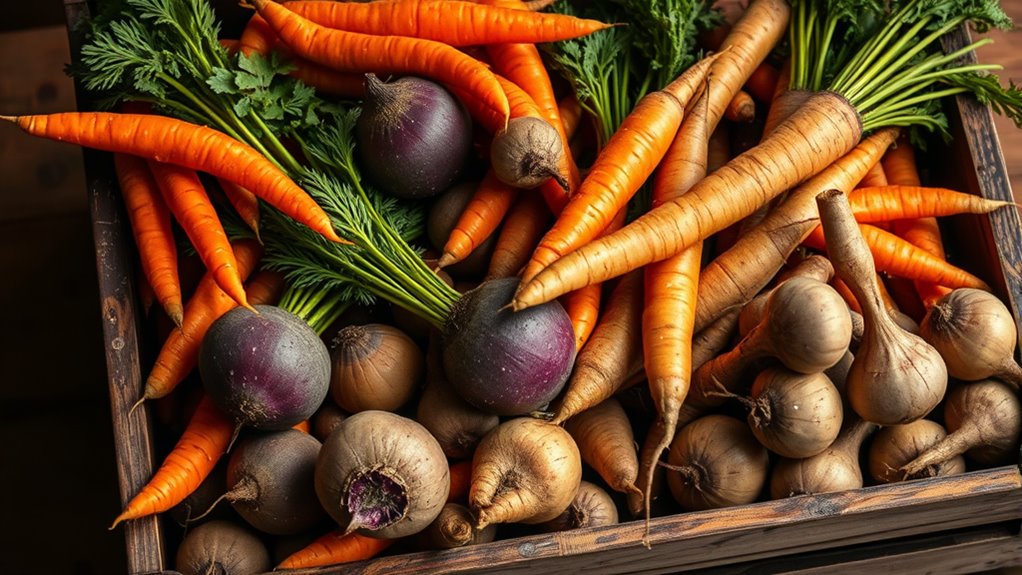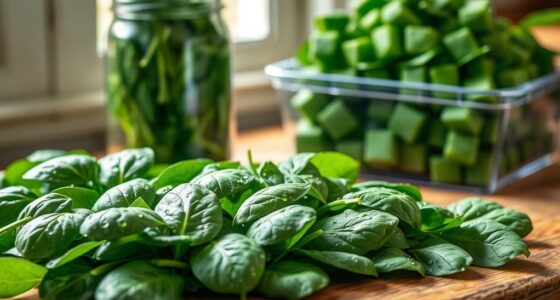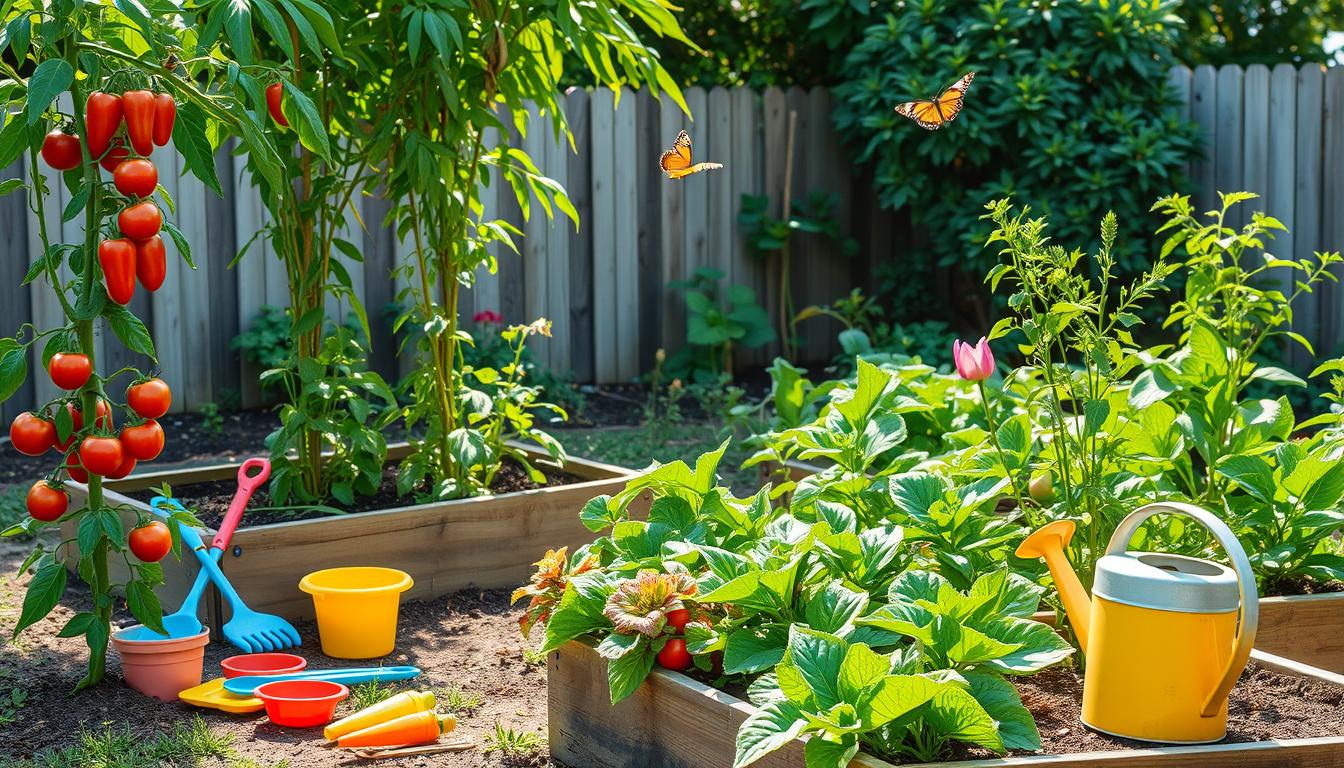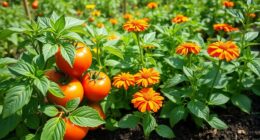For winter storage, consider beets, carrots, garlic, potatoes, and winter squash. Beets and carrots can last up to 10 months and 6 months, respectively, when stored properly. Garlic thrives in cool, dry spots for about 8 months, while potatoes can last 6 to 9 months with the right conditions. If you want to guarantee your vegetables stay fresh, maintaining ideal temperature and humidity is key. Stick around to discover more tips on preserving your harvest!
Key Takeaways
- Beets and carrots can last up to 10 and 6 months respectively with proper storage conditions.
- Garlic can remain fresh for up to 8 months when stored in cool, dry places.
- Potatoes typically last 6 to 9 months if cured and stored in dark, cool environments.
- Winter squash can be stored for 3 to 6 months with appropriate care post-harvest.
- Proper curing, humidity control, and regular inspections are crucial for maximizing storage longevity.
Top Root Vegetables for Winter Storage
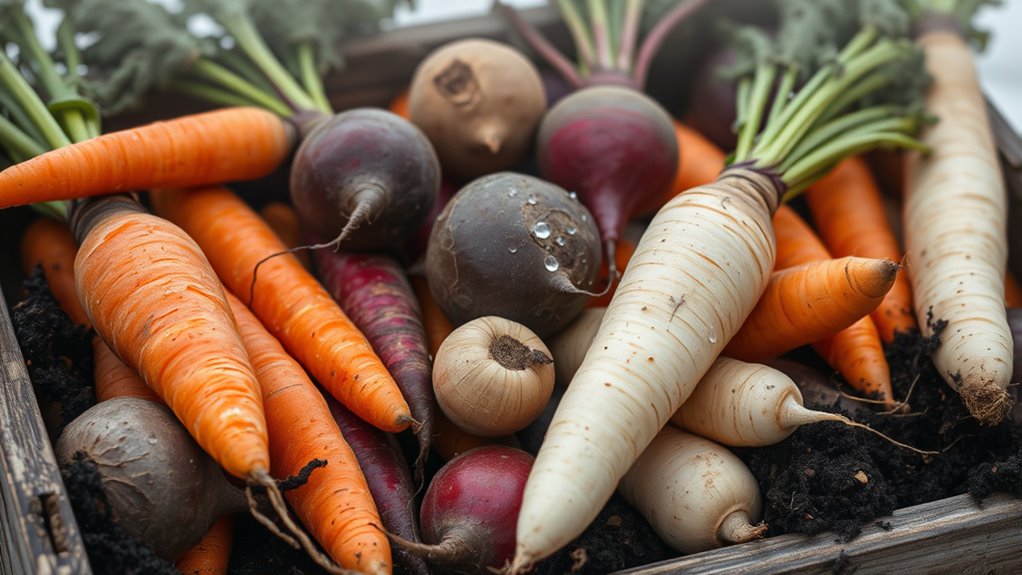
When it comes to winter storage, root vegetables are your best friends.
Beets, like the Luts Winter Keeper and Crosbys Egyptian, can last up to 10 months when you properly cure and store them in cool, humid conditions.
Carrots, such as Bolero and Oxheart, can stay in the ground until it freezes and last for about 6 months, making them perfect for winter harvests.
Garlic varieties like Ks Backyard and Chesnok Red thrive in cool, dry conditions, lasting up to 8 months after curing.
Potatoes, including Kennebec and Yukon Gold, require specific curing methods and can last 6 to 9 months in a cool, dark spot.
Don't forget about winter squash, like Waltham Butternut, which can last 3 to 6 months with proper care.
Ideal Conditions for Storing Root Vegetables
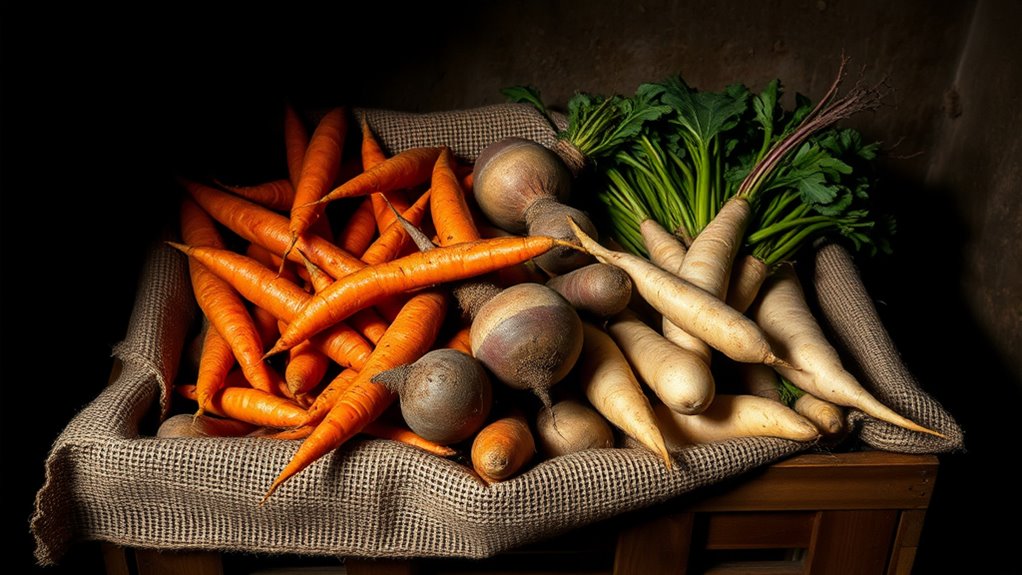
To keep your root vegetables fresh throughout the winter, you'll want to focus on temperature and humidity.
Aim for a chilly environment between 32-40°F with high humidity levels to maximize their storage life.
This careful balance is key to preventing spoilage and maintaining quality.
Temperature Control
Creating the right environment for storing root vegetables is vital for maintaining their freshness and flavor. For the best storage, aim for cold temperatures between 32-40°F.
Root crops like carrots and beets thrive in these conditions, especially with humidity levels at 98-100%. Potatoes prefer around 40°F, while winter squash does better in slightly warmer conditions of 50-55°F with moderate humidity.
It's important to monitor these temperatures regularly, as fluctuations can lead to spoilage and affect quality. Grouping your vegetables based on their specific storage needs enhances preservation and extends their storage life.
Humidity Levels
Maintaining the right humidity levels is just as important as controlling temperatures for storing root vegetables. Ideally, you want humidity levels between 90-100% to prevent dehydration and keep them crisp.
Here are three tips for achieving ideal humidity:
- Use damp sand or sawdust: These materials help retain moisture, creating a suitable environment for root vegetables.
- Inspect regularly: Check your stored vegetables for moisture levels; too much can cause rot while too little leads to dehydration.
- Create microclimates: Use covered bins or damp cloths to maintain a consistent humidity level for long-term preservation in cold storage.
Best Practices for Harvesting and Curing
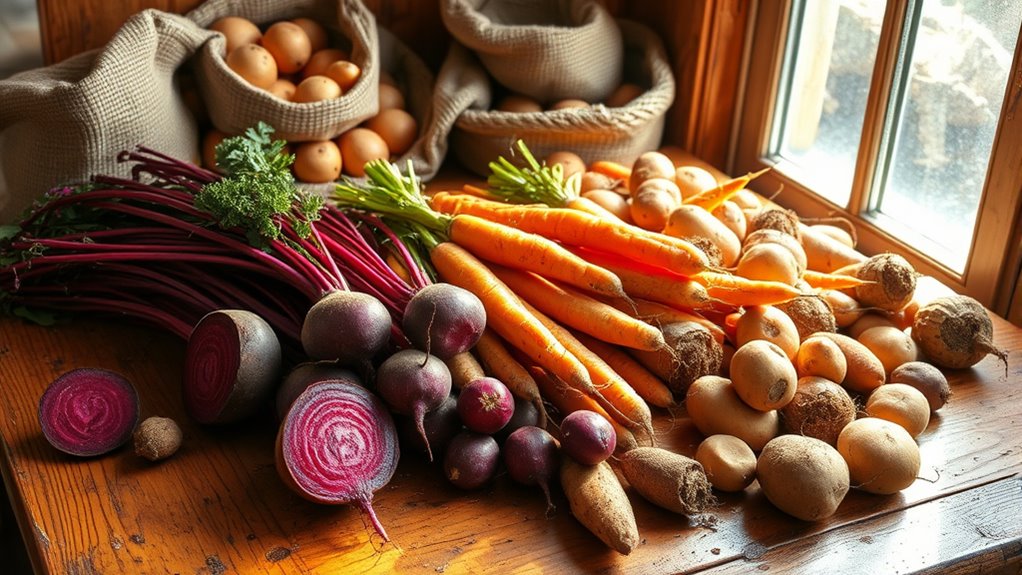
To get the best out of your root vegetables, you need to harvest them at the right time, ideally before the ground freezes.
Once harvested, use effective curing techniques, like keeping potatoes in a dark, ventilated space, to boost their longevity.
These practices will help you maintain quality and prevent spoilage throughout the winter months.
Optimal Harvest Timing
While timing your harvest can greatly affect the quality of your root vegetables, knowing when to pull them from the ground is key to maximizing their sweetness and storage potential. Here are some ideal harvest timing tips for your root vegetables:
- Carrots and Parsnips: Wait until after the first frost; it enhances their sweetness.
- Beets and Turnips: Harvest just before or shortly after the first frost for best storage quality.
- Potatoes: Pull them before the ground freezes. They require proper curing conditions—store in a dark, cool, and humid place to extend their winter storage life.
Don't forget to trim greens to about an inch above the root to prevent decay during storage!
Effective Curing Techniques
After harvesting your root vegetables at the ideal time, the next step is curing them properly to enhance their storage life.
Start by curing potatoes in a single layer in a dark, well-ventilated area at temperatures between 45-60°F for 1-2 weeks. This allows them to develop a protective skin.
For carrots and beets, trim the tops to within an inch of the root to reduce moisture content and prevent decay.
Once cured, store your root vegetables in cool conditions, ideally 32-40°F with high humidity (90-95%).
Regularly inspect stored vegetables for signs of spoilage, like soft spots or mold, and remove any affected items promptly.
These curing techniques will help prolong shelf life and keep your winter storage fresh.
Storage Techniques for Different Vegetables
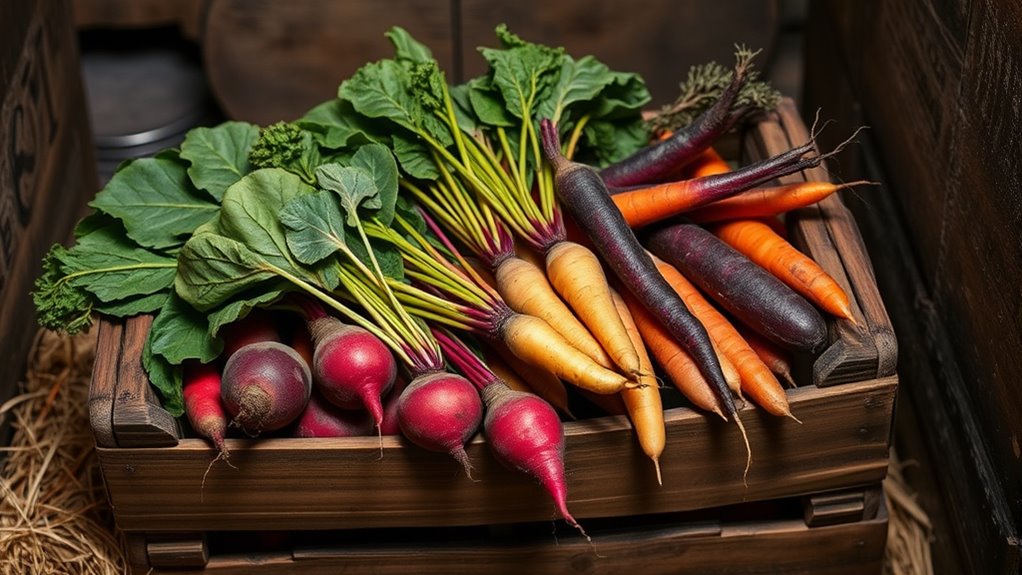
When it comes to storing root vegetables, using the right techniques can make all the difference in preserving their freshness and flavor. Here are some effective storage methods for different vegetables:
- Potatoes, Onions, and Garlic: Cure them in a dark, ventilated space for 1-2 weeks. This helps extend their storage life during the winter months.
- Carrots, Beets, and Parsnips: Store them in damp sand or sawdust in cool, humid conditions to maintain moisture and prevent rot.
- Winter Squash and Pumpkins: Cure in a warm, dry spot before moving to cooler storage (50-55°F) with moderate humidity for long-lasting storage.
Regularly inspect your stored root vegetables to remove any damaged produce and prevent spoilage.
Monitoring Temperature and Humidity
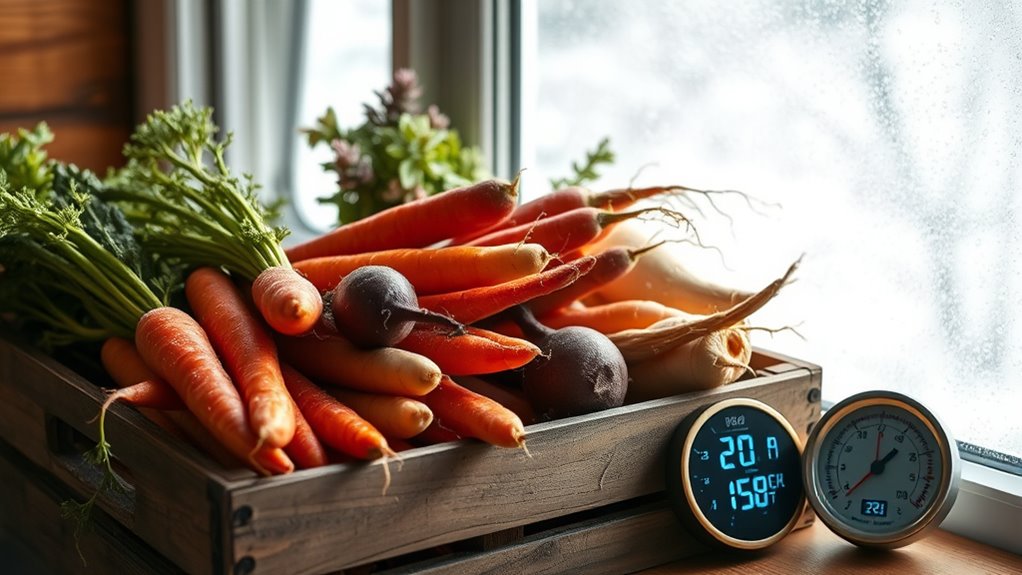
How can you guarantee your root vegetables stay fresh throughout the winter? Start by maintaining an ideal temperature range of 32-40°F in your storage area. This temperature inhibits spoilage and keeps your root vegetables like potatoes and carrots in prime condition.
Next, make certain the humidity level stays between 90-95%. High humidity prevents dehydration and preserves crispness. Regularly monitor these conditions, as fluctuations can cause condensation and mold growth, ruining your produce.
Consider using damp sand or sawdust to create a microclimate that retains moisture.
Finally, check your stored vegetables weekly for signs of rot. Removing any damaged items promptly can help prevent the spread of decay to healthier root vegetables, making sure a successful winter storage.
Common Mistakes to Avoid in Vegetable Storage
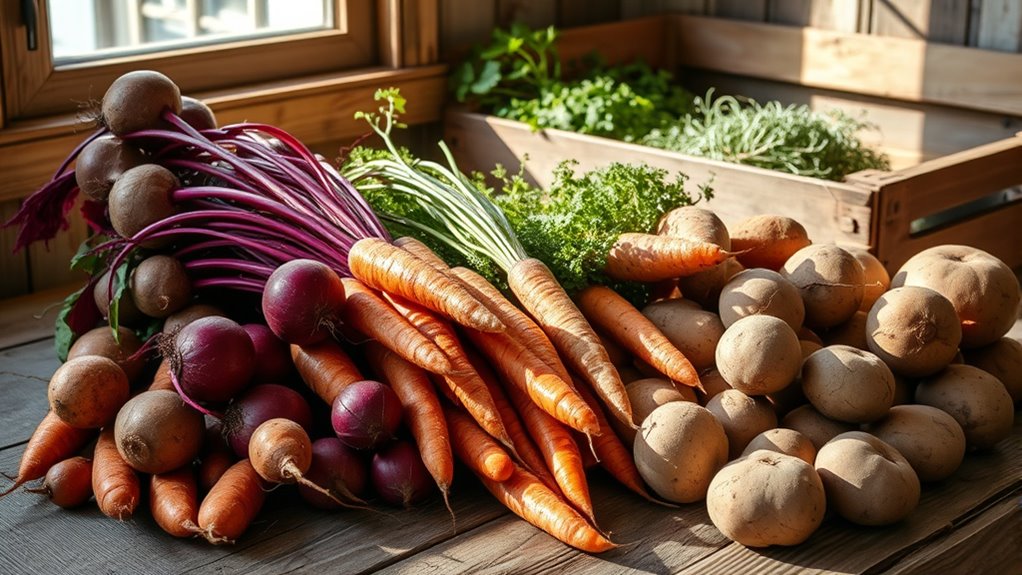
Even with the right temperature and humidity, mistakes in vegetable storage can lead to wasted produce.
To keep your root vegetables fresh in your root cellar, avoid these common pitfalls:
- Curing Potatoes: Failing to cure potatoes before storage can cause early spoilage, so always take this step.
- Ignoring Temperature & Humidity: Storing vegetables to store like carrots and beets above 40°F or neglecting humidity levels can lead to rot or desiccation.
- Overpacking Storage: Overpacking storage bins restricts airflow, increasing the risk of spoilage. Always leave space between vegetables for ventilation.
Selecting Heirloom Varieties for Longevity
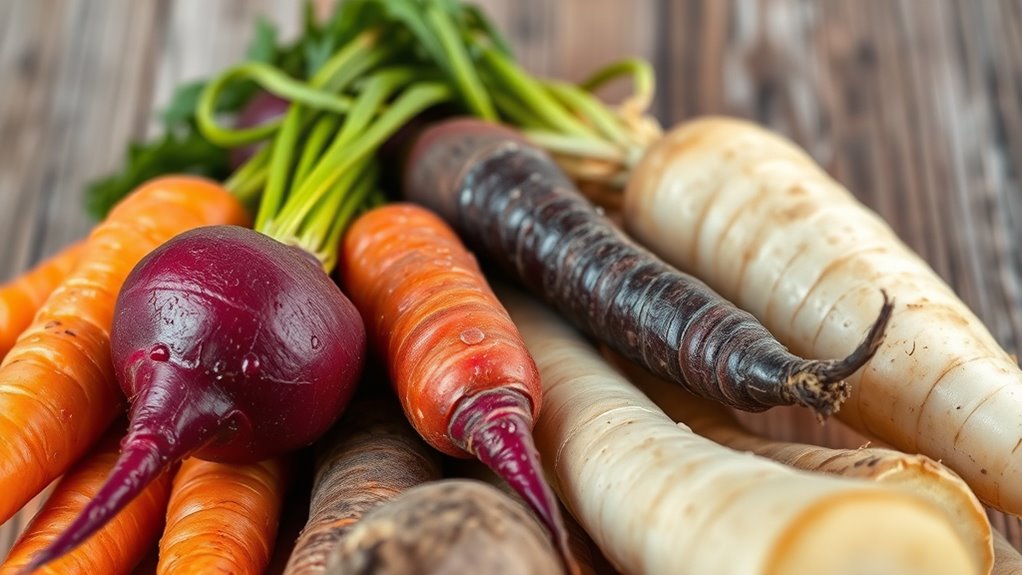
Selecting heirloom varieties of root vegetables can greatly enhance your winter storage experience, as these time-honored crops often boast superior flavor and longevity.
Choose varieties like "Crosbys Egyptian" beet or "Hollow Crown" parsnip, known for their exceptional storage capabilities. Carrots like "Danvers 126 Half Long" have a rich history of resilience, ensuring they remain fresh throughout winter.
Don't overlook "Brunswick" cabbage, celebrated for its cold hardiness and impressive storage capacity, perfect for winter preservation. Heirloom sweet potatoes, such as "Beauregard," not only mature early but also sweeten during storage, making them a delightful staple.
Creative Uses for Stored Vegetables

After choosing the right heirloom varieties for winter storage, you'll want to make the most of your harvest. Here are some creative uses for your stored vegetables:
- Hearty Soups: Combine root vegetables like carrots, beets, and parsnips for warming winter soups that nourish you during cold months.
- Savory Sides: Mash or roast celeriac and rutabaga to add unique flavors to your winter meals.
- Versatile Dishes: Puree stored winter squash varieties like butternut for soups or bake them into casseroles.
Don't forget garlic and onions; they're essential flavor enhancers perfect for sautés and sauces.
Plus, transform potatoes into comforting gratins or baked potatoes, ensuring they stay a staple throughout the winter season. Protein-rich options like roasted root vegetable medleys can also enhance the nutritional value of your meals. Enjoy your delicious bounty!
Frequently Asked Questions
What Vegetables Are Good for Winter Storage?
When it comes to winter storage, you'll want to contemplate vegetables that can withstand the cold. Carrots, potatoes, and beets are great choices, as they can last for months if stored properly.
Celeriac and parsnips also hold up well, adding unique flavors to your winter meals. Just make sure you keep them in a cool, humid environment to maintain their quality and freshness throughout the season.
Happy storing!
Which Vegetables Are Best Stored in Cold Storage?
When you're considering which vegetables are best stored in cold storage, focus on root varieties like carrots, beets, and turnips.
They thrive in temperatures between 32-40°F with high humidity. Make sure to harvest them at the right time, ideally before the ground freezes.
Regularly check your stored vegetables for any signs of spoilage, as damaged produce can spoil others. Proper care will help your storage last throughout the winter months.
How to Store Root Vegetables for the Winter?
To store root vegetables for winter, harvest them just before or after the first frost.
Pack them in bins with moist soil, layering to maintain moisture. Keep your storage environment cold, ideally between 32-40°F, with high humidity levels.
Regularly check for spoilage, removing any damaged produce to protect the rest. Using damp sand or sawdust can help regulate moisture and keep your root vegetables fresh throughout the winter months.
What Are the Long Lasting Root Vegetables?
When you're considering long-lasting root vegetables, look for reliable options like beets, carrots, celeriac, parsnips, and rutabagas.
These sturdy staples stand up well to storage. Beets can boast a lifespan of 5 to 10 months when cured properly, while carrots, especially the Oxheart variety, hold strong for up to six months.
Parsnips sweeten after frost, and celeriac thrives in cool, humid conditions, offering delightful diversity in your winter meals.
Conclusion
In the chill of winter, while fresh produce dwindles, your root vegetables can thrive in storage, providing warmth and nourishment. By understanding the ideal conditions and best practices, you can transform what seems like a barren pantry into a treasure trove of flavor. Don't let common mistakes sabotage your efforts; embrace heirloom varieties and creative uses to make the most of your harvest. With a little care, your winter meals can be as vibrant as the summer garden.

